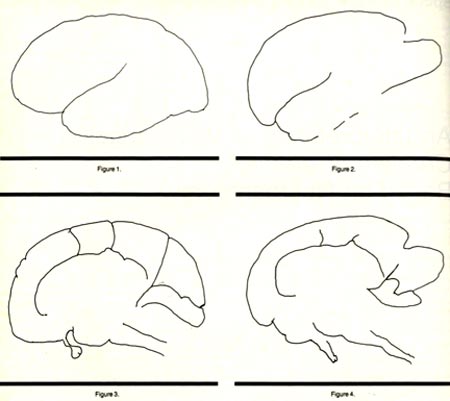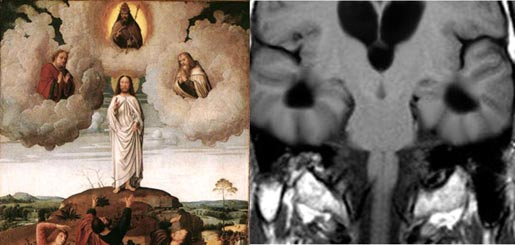
Michelangelo’s Creation of Adam
From Paluzzi et al., Journal of the Royal Society of Medicine, 2007
For a few years, Nature Reviews Neuroscience stuck to a humorous theme in its cover art: everyday objects that mimic brains. A dandelion, spilled wine, a rock, a cave painting: if you know what features to look for, a surprising number of things resemble brains. We are a species that sees faces on the Martian surface and the Moon; we’re very good at pattern recognition, and it’s probably evolutionarily better for our brains to err on the side of “recognizing” something that isn’t there, than vice versa.
That’s why I’m skeptical of a recent paper by four UK scientists, resurrecting an idea nearly two decades old: that Renaissance painters planted hidden neuroanatomical imagery in their paintings.
This idea apparently originated with gynecologist Frank Meshberger. In 1990, Meshberger proposed that Michelangelo’s Sistine Chapel fresco, The Creation of Adam, represents a midsaggital view of the human brain. He argued that the prominent violet oval of God’s billowing cloak outlines the cerebrum, the bump in the front is the Sylvian fissure, and the dangling angels’ legs depict the pituitary and spinal cord. The foot of the frontmost angel is strangely shaped – Meshberger calls it “bifid” – which is consistent with a bilobed pituitary.
The thesis is attractive because it fits the message of the painting: God is giving the divine spark of life to Adam. Couldn’t that spark be wisdom, or intelligence? Meshberger thought so: “the larger image encompassing God is compatible with a brain. Michelangelo portrays that what God is giving to Adam is the intellect.” We know Michelangelo was fascinated by human anatomy; like Leonardo da Vinci, he dissected cadavers, and could plausibly have made and studied a midsaggital brain section. Meshberger’s original paper includes a series of striking figures where he pairs tracings of modern anatomical illustrations (by the renowned Frank Netter, on left) with tracings of the fresco, on right:

from Meshberger, FL, JAMA, 1990
The resemblance is obvious. But is it intentional?
In December, a group of UK-based neuroscientists led by Alessandro Paluzzi extended Meshberger’s hypothesis to two other Renaissance paintings: Rafael’s Transfiguration of Jesus and Gerard David’s Transfiguration of Christ. To my eye, the Rafael bears no resemblance to a brain whatsoever; even the authors note, “[the resemblance] may not be immediately obvious at first sight (and perhaps it was not meant to be).” But the David is strikingly similar to a midline coronal section of the human brain, cropped just right, with Elijah and Moses perched in the ventricles. Judge for yourself:

David, Transfiguration of Christ; coronal section of human brain
From Paluzzi et al., Journal of the Royal Society of Medicine, 2007
Is it wrong that Elijah and Moses remind me of Statler and Waldorf?
Despite my skepticism, Paluzzi and colleagues aren’t alone in finding Meshberger’s point of view alluring. In 2006, Michael Salcman revisited Meshberger’s hypothesis, citing putative anatomical influences in other works by Michelangelo, including another part of the Sistine Chapel fresco that he says resembles a “bisected right kidney.” However, Salcman also admitted, “a cynic might suppose that neurologists and nephrologists are prone to discover brains and kidneys everywhere.”
What can I say – I’m just such a cynic. As far as I’m concerned, a 1990 NYT article by Natalie Angier (she’s had the science beat for a long time) says it all too well:
‘I certainly see how he had the idea, but I think it is a retrofit of his own modern knowledge onto Renaissance culture,” said Dr. Kathleen Weil-Garris Brandt, a professor of fine arts at New York University and a consultant for Renaissance art at the Vatican Museum.
”All the elements in the image have profound traditional roots in the visual culture of the Renaissance and Middle Ages. God is more than a flying brain.”
Wouldn’t it be cool if God were a flying brain? (Or a flying spaghetti monster? But I digress.)
Unfortunately, no matter how intriguing these resemblances, we have no explanation for why master artists of the Renaissance would have concealed brain imagery in their work. Paluzzi et al. don’t claim to have an answer, although they suggest “perhaps this was a tongue-in-cheek send-up of religious themes, unbeknownst to the commissioners of the paintings, or maybe just the product of a new philosophical climate where a revitalized passion for life sciences was permeating all aspects of society, including art.” An in-joke/symbol that only a handful of self-educated anatomist-artists could appreciate? That’s a little too Da Vinci Code for me. Still. . . wouldn’t it be cool if it were true?
References
Angier, Natalie, “Michelangelo, Renaissance Man of the Brain, Too?” NYT, October 10, 1990.
Meshburger, FL, “An Interpretation of Michelangelo’s Creation of Adam Based on Neuroanatomy”, JAMA, Vol 264, October 1990. Pubmed
Paluzzi et. al, “Brain ‘imaging’ in the Renaissance”, Journal of the Royal Society of Medicine, Vol. 100, December 2007. Pubmed (subscription) (Via Street Anatomy)
Salcman, Michael, “The Creation of Adam by Michelangelo Buonarroti (1475-1564)”, Neurosurgery, Vol 59, December 2006. Pubmed
